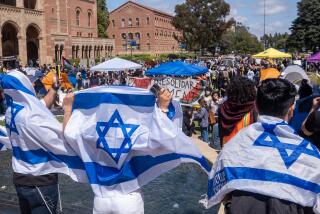Campus Correspondence : Self-Segregation on Campus: What Happened to the Goal of Diversity?
BERKELEY, CALIF. — Diversity is alive and well-represented on the UC Berkeley campus. But can it exist without a separation of races and ethnic groups? Even more important, can separation coexist with toleration and intermingling? It appears as though pluralism is not being achieved at Cal.
When I arrived in the fall, 1989, I was in awe of how many “minority” groups were represented. There appeared to be no majority of any particular group. Since I’d attended a predominantly white high school in Orange County, the change in environment was wonderful.
Now, however, I’m beginning to see a disturbing pattern of identification among the student population. Each group stays within its own boundaries, within its own territory. The black students sit together on the left side of Sproul Plaza, the Latinos occupy another corner, the Asian students assemble somewhere else and the whites mostly disappear to their sororities and fraternities.
What happened to socializing among the “diverse student population” of UC Berkeley? What happened to the goal of diversity: a mixed campus population conducive to promoting understanding of other customs and peoples?
Rather than gaining understanding and forming friendships, students seem less tolerant. Polarization along the lines of skin color is increasing at Berkeley.
Most students dwell on their differences instead of their similarities. My friend Taja expressed her disappointment and anger at the formation of pockets of ethnic groups around campus. “I thought I would come to Berkeley and be respected for me--not be judged by my ideology, class and color. I didn’t think I had to choose sides to fit in.”
By choosing sides, she means either hanging out with the “radical” black students, the “middle-class” blacks or the “middle-class whites.” Students trying to find their social niche place strong emphasis on physical distinctions. We must find a way to see beyond this limiting behavior.
Students also separate themselves in the dining commons. “It’s very obvious that the Asians sit among each other and rarely make an effort to bring outsiders into their group,” said my friend Lisa. “Often times they speak their mother tongue. Also, within the group there is separation among the Chinese and the Filipinos. This has a lot to do with their upbringing; their parents tell them to marry an Asian, to stick together.”
The separation is not only among Asians but among other groups as well. And it is not particular to eating areas. Even in classes and at social functions, the separation is evident.
Separation as such is not really the main problem. Understandably, security is easier found among your own people. The real problem is the lack of tolerance each group seems to display toward others and the lack of importance placed on individuality instead of group identity.
Each group has its own excuse. Blacks do not mix with whites because they are not brothers and sisters; whites do not mix with blacks because they are not accepted; Asians do not mingle with blacks because their cultures and customs differ; Latinos do not mix with Asians or whites because each doesn’t understand the others’ music or eat the same food or whatever.
The saddest part is that the students impose these racial and ethnic cliques on themselves. What does that say for the possibilities of working together when we graduate? If we persistently focus on our obvious differences--like skin color and religion and origins--we will never be able to live together in one United States of America. The melting-pot concept is a myth, but we must learn to respect our differences and emphasize our common traits, or we will live in a polarized society.
The other day as I was walking through lower Sproul, I noticed a group of children--probably 6 or 7 years old--on a field trip.. There were black boys and girls playing with Latino boys and girls. They would hold hands and run after each other, clearly enjoying each other’s individual personalities.
Then as I made my way up the steps to upper Sproul Plaza, I noted the conspicuous absence of colorblind friendships. Each race was occupying a different corner of the plaza. Maybe elite, intelligent college students could learn a few things from those children.
More to Read
Sign up for Essential California
The most important California stories and recommendations in your inbox every morning.
You may occasionally receive promotional content from the Los Angeles Times.










